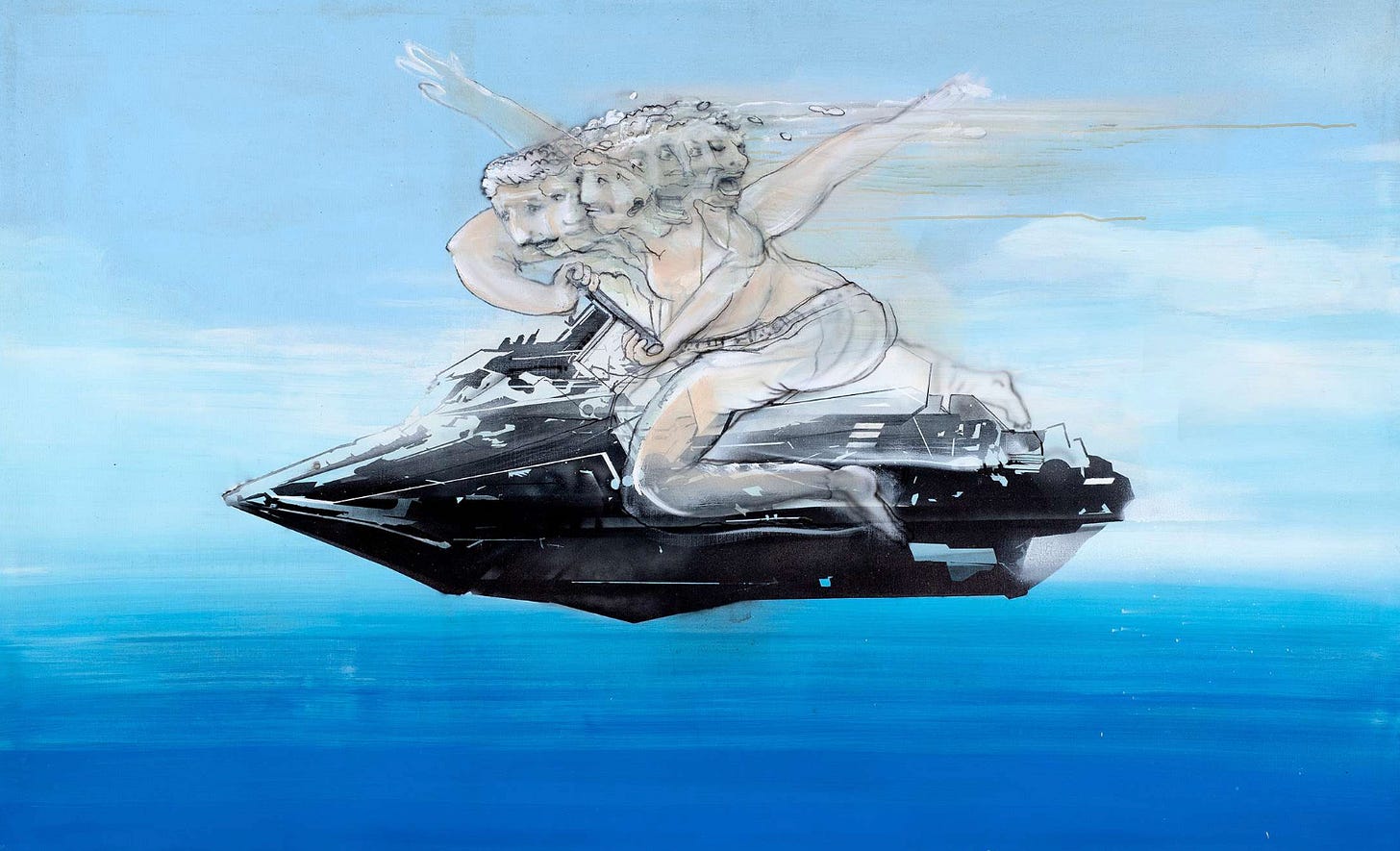What comes to mind when you hear the words “tech” and “art” together?
NFTs? Generative AI? Elon Musk beaming an artwork into space?
Too often, the intersection of technology and art skews toward the flashy and gimmicky, leaning into novelty rather than substance. But Swiss-born artist Pascal Sender navigates this space differently, seamlessly integrating technology into his practice without sacrificing artistic integrity. This is evident in his latest exhibition, Happy Hour, on view at Saatchi Yates in London until April 6, 2025.
Sender (b. 1988) studied under Peter Doig at Kunstakademie Düsseldorf before relocating to London in 2018 to attend the Royal Academy Schools. Our first encounter with his work was in 2020 at the RA Schools Premiums interim show, where he exhibited Gleichda, a striking abstract painting featuring WhatsApp message bubbles and a cryptic QR code.
Curious, we scanned the code and were immediately called by a random number. Was this part of the artwork or just a bizarre coincidence? It was one of those embarrassing art world moments where we quickly moved on, hoping no one saw the confused look on our face as we whispered “Hello?” and swiftly hung up the phone. As it happens, the call was just a coincidence and the QR code was in fact intended to lead visitors to an Instagram filter that enhanced the artwork with augmented reality (AR). Oops!
AR has become one of Sender's signature artistic devices and his innovative approach caught the attention of the gallerists Phoebe and Arthur Saatchi Yates. Still only a few years into his RA Schools programme, by October 2020, Sender became the first artist to have a solo show at Saatchi Yates, marking the launch of their inaugural London space, formerly on Cork Street.
The exhibition showcased a full body of work that celebrated Sender’s technological explorations in all their glory. Exemplified in a standout work from the show, Dance 9 (2019), the exhibition was comprised of several large-scale paintings and smaller works on paper, all activated through a self-coded app. Each artwork functioned as a portal, enticing visitors to explore Sender’s surreal and animated third dimensions through their phones.
We wrote on Instagram at the time: “First off, @pascalsender can PAINT! The works in this exhibition are stunning in their traditional 2D form alone... but then comes the AR app. Coded by Sender himself, the app propels his intricate compositions into the third dimension, bringing the works to life and transporting viewers into a new digital reality.”
Sender’s debut solo show drew attention from institutions across Europe, particularly in Germany and Switzerland, leading to group exhibitions at Kunstmuseum Solingen, Kunstmuseum St. Gallen and Museum Kunstpalast, Düsseldorf. His practice has continued to evolve, culminating in his second solo exhibition at Saatchi Yates, Happy Hour. This latest show builds upon his signature fusion of traditional painting and AR technology.
The press release for Happy Hour highlights Sender’s engagement with art historical references: “Boccioni’s iconic bicycle is replaced with modern electrified modes of transport: a jet ski, a dune buggy, a scooter. Similarly, a Picasso-style Cubist study of an acoustic guitarist is reimagined as a head-banging electric guitarist, each strum generating bolts of lightning.”
Much like how Boccioni implied movement with energetic and layered line work, Sender similarly uses line to suggest motion in the two-dimensional realm; however Sender’s ability to incorporate AR as an additional layer allows him to fully animate these gestures. For example, while the jet ski’s momentum is evident on the canvas, it is only when viewed through the AR filter that its movement transcends the static medium and burst into dynamic action.
Discussing his current show with The Wick founder, Katy Wickremesinghe, Sender explains how AR enhances his work: “I thought a lot about how time flows. All of the works are about flow state. Whenever the iPad sees in full a painting, it immediately tracks it and overlays it with a video. I generated or collected a lot of videos and they get picked at random.”
What sets Sender apart is that his paintings stand strong on their own. Unlike much of today’s tech-based art, his AR elements don’t feel like an afterthought or a crutch—they are the final piece of the puzzle, completing an already compelling body of work. Happy Hour exemplifies how technology can be meaningfully woven into art, avoiding gimmickry while pushing the boundaries of traditional mediums. With this new show, Sender once again proves that digital innovation and high art don’t have to be mutually exclusive. Like a good gin and tonic, they can complement each other perfectly.
If you’re in London, this is one Happy Hour you won’t want to miss!
Check out Pascal Sender’s Happy Hour exhibition here and his crazy website here.









ok